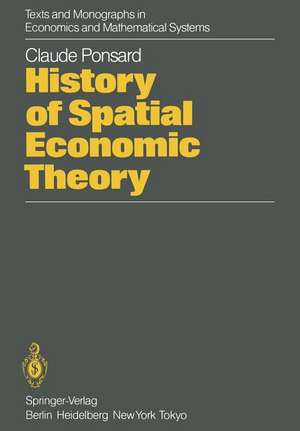History of Spatial Economic Theory: Texts and Monographs in Economics and Mathematical Systems
Autor C. Ponsard Traducere de B. H. Stevens, M. Chevaillier, J. P. Pujolen Limba Engleză Paperback – 14 dec 2011
Preț: 640.24 lei
Preț vechi: 753.22 lei
-15% Nou
Puncte Express: 960
Preț estimativ în valută:
122.55€ • 133.16$ • 103.01£
122.55€ • 133.16$ • 103.01£
Carte tipărită la comandă
Livrare economică 21 aprilie-05 mai
Preluare comenzi: 021 569.72.76
Specificații
ISBN-13: 9783642821271
ISBN-10: 3642821278
Pagini: 256
Ilustrații: XII, 240 p.
Dimensiuni: 170 x 244 x 13 mm
Greutate: 0.41 kg
Ediția:Softcover reprint of the original 1st ed. 1983
Editura: Springer Berlin, Heidelberg
Colecția Springer
Seria Texts and Monographs in Economics and Mathematical Systems
Locul publicării:Berlin, Heidelberg, Germany
ISBN-10: 3642821278
Pagini: 256
Ilustrații: XII, 240 p.
Dimensiuni: 170 x 244 x 13 mm
Greutate: 0.41 kg
Ediția:Softcover reprint of the original 1st ed. 1983
Editura: Springer Berlin, Heidelberg
Colecția Springer
Seria Texts and Monographs in Economics and Mathematical Systems
Locul publicării:Berlin, Heidelberg, Germany
Public țintă
ResearchCuprins
1. Before Thunen.- Section 1. Space in 18th Century Economic Thought.- Section 2. The Break Between Spatial Analysis and the English Classical School.- 2. Johann-Heinrich Von Thunen.- Genesis of Thunen’s Theories.- Section 1. The Model of Concentric Rings.- Section 2. Thunen and His Time.- Conclusion.- 3. From Thunen to Weber.- Section 1. The Anglo-Saxon Descriptions.- Section 2. Towards the First German Deductive Theories.- 4. Alfred Weber.- Historical and Theoretical Background of the Weberian Analysis.- Section 1. Parameters and Assumptions.- Section 2. The Three Types of Location Orientation.- Section 3. The System of Locations.- Conclusion.- 5. From Weber to Palander.- Section 1. Andreas Predohl.- Section 2. From Englander to Christaller.- Section 3. From Fetter to Ohlin.- 6. Tord Palander.- The Goals and Methods of Palander’s Theories.- Section 1. Market and Location.- Section 2. Transport Cost, Location of Production, and Market Size.- Section 3. Conditions of Competition and Location.- Conclusion.- 7. From Palander to Losch.- 8. August Losch.- The Background for Losch’s Theories.- Section 1. The Theory of Location.- Section 2. The Theory of Regions.- Section 3. The Theory of Exchange.- Conclusion.- 9. From Losch to the Nineteen Fifties.- Section 1. Partial Spatial Equilibria.- Section 2. General Spatial Equilibrium.- 10. Since the Nineteen Fifties.- The Scientific Environment During the Second Half of the 20th Century.- Section 1. The Paradigms.- Section 2. New Directions.- Conclusion.- Conclusion.- Mathematical Appendix.- I. Von Thunen’s Models.- 1. Concentric Rings.- 2. Theory of the Natural Wage.- II. Weber’s Models.- 1. The Point of Minimum Transport Cost.- 2. Labor Deviation (The Isodapane Technique).- 3. Agglomeration.- III. Palander’s Models.-1. The Delineation of the Market.- 2. Price Policy and Transport Costs.- 3. Isoline Technique.- 4. Law of Refraction.- 5. Conditions of Competition and Location.- IV. Losch’s Models.- 1. Location of Two Agricultural Products.- 2. The Equations of General Spatial Equilibrium.- 3. Economic Regions.- 4. Spatial Differentiation of Prices.- Chronological Bibliography.- Author Index.











